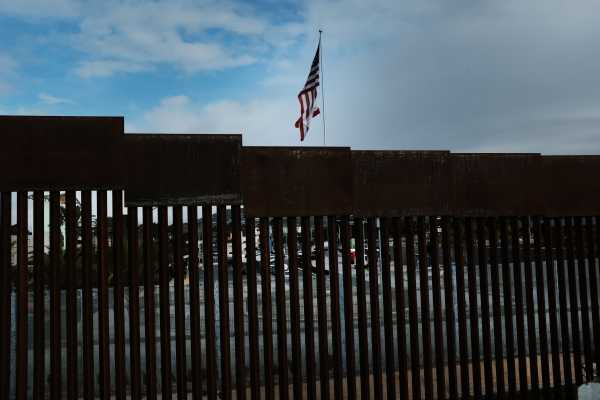
The practical realities of building new physical barriers along the US-Mexico border are bringing two cherished conservative principles into conflict — loyalty to Donald Trump and the sanctity of private property.
Trump’s wall would require turning private property into public land, a prospect that appalls Texans like Eloisa Cavazo. She says she’d never take a buyout from the government: “You could give me a trillion dollars and I wouldn’t take it,” she told the Associated Press.
Republicans and Trump have argued that eminent domain gives them the power to do it. Eminent domain is invoked when the government takes possession of private land for public use — and conservatives despise it.
But Trump has long supported the use of eminent domain, using it when he was working in real estate and defending the concept during the 2016 presidential campaign. He argues that it will prove essential in getting a border wall built. “You have to use eminent domain,” Trump said during a Rose Garden briefing. “If we had one person that wouldn’t sell us … then we wouldn’t be able to build proper border security because we’d have that big opening.”
But while Trump might be a long-time supporter of eminent domain, conservatives aren’t. And that leaves a swath of the right in a difficult situation: support the building of a border wall that will require massive government intrusion into private property, or defy the president and his base.
What is eminent domain?
Eminent domain is the power of the government to take private land or property and convert it to public use. It is rooted in the Fifth Amendment to the Constitution, which says “nor shall private property be taken for public use, without just compensation.”
Typically, the government uses eminent domain to take private land for public use. In general, that means infrastructure, like roads or, as the Trump administration will argue, a border wall. And the process by which the government reaches out to private landowners is generally clear-cut — and markedly one-sided in favor of the federal government.
Join the Vox Video Lab
Go behind the scenes. Chat with creators. Support Vox video. Become a member of the Vox Video Lab on YouTube today. (Heads up: You might be asked to sign in to Google first.)
Eminent domain is how the federal government protected the land where the Battle of Gettysburg was fought in 1896. And in the 1970s and 1980s, a number of federal courthouses and the Washington, DC, Metro system were constructed on land obtained via eminent domain.
As David Bier detailed for Reason magazine in 2017, the use (or, in the view of some landowners, abuse) of eminent domain on the US-Mexico border has extended through multiple presidential administrations. In Texas, the vast majority of the land on the border is held by private owners, states, or Native American tribes. While the government has tried to use eminent domain to get access to that land before, the resulting lawsuits created massive construction delays.
How eminent domain works
The process by which the government can take private land to use it for public purposes is fairly straightforward.
Lawrence Tribe, a professor of constitutional law at Harvard Law School, told me that when a private landowner is approached by a government agency that wants their land, that agency “typically gives them a deadline by which they must either sell the designated parcel of land to the federal government at the price offered by the government, or have it involuntarily taken by eminent domain at fair market value.” On the border, that agency might be the Department of Defense, the Corps of Engineers, or the Federal Emergency Management Agency.
The government has all of the power in these conversations, Tribe said. The government rarely gets involved in “extended negotiations” with landowners. In cases where landowners don’t accept settlements from the government, he said, “the government would get a court order condemning the land and would proceed to dig or do whatever is required by the project.”
Individuals and private landowners — like a church congregation, for example — do have some recourse when the government asks for their land. They can attempt to argue that the government isn’t paying enough for their property, or that the statute the government is using to take their property doesn’t apply.
Hundreds of landowners have challenged the government since 2006, when President George W. Bush signed the Secure Fence Act and spurred a flurry of federal border land purchases. They’ve taken the government to court in proceedings that can last more than three years on average. And while those suits don’t typically lead to landowners keeping their land, it does make life difficult for the federal government. A 2009 Department of Homeland Security report found that the effort to take private property for border fencing was “a costly, time-consuming process.”
This is a little different from how real-estate magnates — like a pre-presidency Donald Trump, for example — have used eminent domain, particularly following the 2005 Supreme Court decision Kelo v. New London. That decision found that the government could interpret “public use” as including any potential economic benefits to the public that might arise from taking private land for private development projects. Like to build, say, a doomed casino. In an interview with Fox News, Trump said that he agreed with the Kelo decision “100 percent.”
Unconservative arguments run amuck
Among many conservatives, the principle of eminent domain is broadly unpopular, a prime example of government overreach. That goes double when eminent domain is practiced for the benefit of private corporations.
In fact, one of the major conservative criticisms of Donald Trump’s presidential candidacy was over his enthusiastic support for eminent domain, as in this 2015 Club for Growth ad.
But on the issue of a border wall, conservatives seem somewhat sanguine about the prospect of the government seizing private land to build it, arguing that the wall is public infrastructure and those who have their land seized will get compensation. In one interview, Sen. Ted Cruz (R-TX) said, “Securing the border is a legitimate area for eminent domain where landowners would get reasonable and just compensation.”
HotAir writer Jazz Shaw argued last week that eminent domain would be “certainly” be a legal option for Trump, arguing that “a wall that protects the citizens from foreign invaders is ‘used’ by everyone.” Shaw concludes that perhaps the United States-Mexico border itself could simply be moved, with property owners who object to the wall going through their property simply placed on the other side. “Of course, as soon as the landowners learn that they’re about to find themselves on the wrong side of the wall,” Shaw wrote, “they may reconsider that whole negotiating thing.”
John Malcolm, vice president for the Institute for Constitutional Government at Heritage, told me that as long as the president has the authority to use eminent domain, there’s no “eminent domain problem.” He added: “The government could seize the land, but would have to pay ‘just compensation’ to the landowner.”
That’s true. But that doesn’t matter very much to the landowners who refused to sell their land to the federal government during Bush’s presidency, and who won’t do so today. Particularly since, in some cases, the government is taking land before paying that “just compensation” for it, a process known as “quick take” eminent domain. In short, “quick take” ensures that the government already owns the land long before it decides to pay the people who originally owned it. Rep. Justin Amash (R-MI) introduced a bill to end this practice last week.
The legality of eminent domain is clear. Yes, the government can in fact take your private land for public use. But the politics of the practice are far less defined, as Trump floats the “military version of eminent domain” and continues to put conservatives who have long opposed the seizure of private property for public use in between a rock and a hard place.
As Sarah Quinlan wrote for RedState:
As the government shutdown continues, even getting funding for a border wall seems difficult to imagine, let alone beginning the process of obtaining the land needed to build it. But for thousands of landowners on the southern border, the government taking their land, even sometimes before they pay for it, isn’t difficult to imagine — it’s already happening. And for conservatives, eminent domain poses a question: Is government intrusion into private property okay if it’s to build something that conservatives want?
Sourse: vox.com






